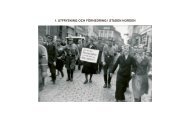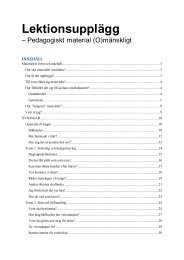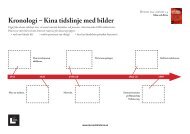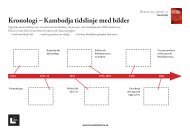Children…
Tell Ye Your Children... - Levandehistoria.se
Tell Ye Your Children... - Levandehistoria.se
- No tags were found...
Create successful ePaper yourself
Turn your PDF publications into a flip-book with our unique Google optimized e-Paper software.
“We ceased to work, and the German soldiers and civilians ran<br />
to the shelters. Most of us didn’t. So probably, we expressed our<br />
superiority feeling, and a kind of revenge. We had nothing to lose,<br />
only expected to enjoy the destruction of the big factory we were<br />
building for the I.G. Farben Industrie. It was naturally so.<br />
This happy feeling didn’t change also after the Americans<br />
indeed, began to bomb, and we had casualties too—wounded<br />
and dead. How beautiful was it to see squadron after squadron<br />
burst from the sky, drop bombs, destroy the buildings and kill<br />
also members of the Herrenvolk.<br />
Those bombardments elevated our morale and, paradoxically,<br />
awakened probably some hopes of surviving, of escaping from<br />
this hell. In our wild imagination, we also saw a co-ordination<br />
between the Allies and the indeed small underground movement<br />
in the camp, with which I was in touch. We imagined a coordinated<br />
destruction and escape; destruction from above by the<br />
bombers, and from our hands, while escaping, even if we have to<br />
be living bombs—to be killed. Unfortunately, this never occurred.”<br />
SHALOM LINDENBAUM, AUSCHWITZ-MONOWITZ SURVIVOR<br />
Bombing Auschwitz<br />
From May to July 1944, the world looked on as the<br />
Germans deported hundreds of thousands of Hungarian<br />
Jews, through Slovakia, to be gassed at Auschwitz-<br />
Birkenau. Many individuals and organisations pleaded<br />
with the Allies to do something to stop the killing. The<br />
idea of bombing the Birkenau death camp, whose function<br />
was known to all, was especially promoted. Bombing<br />
the railways to the camp was also urged.<br />
The war was in its last year and the Allied air forces<br />
ruled the skies of Europe. American bombers flying<br />
from Italy passed almost daily over or near the camp.<br />
Sometimes, they took high-altitude photographs of<br />
Birkenau. These pictures, analysed only at the end of<br />
the 1970s, show different phases of the mass murder.<br />
Yet for a number of reasons, American and British<br />
officials refused to order the camp bombed. Some of<br />
the official explanations appear cynical. British Minister<br />
Richard Law delayed answering Chaim Weizmann,<br />
a prominent Jewish leader, for two months after his<br />
request was made. In September 1944, he finally wrote:<br />
“The matter received the most careful consideration of<br />
the Air Staff, but I am sorry to have to tell you that, in<br />
view of the very great technical difficulties involved, we<br />
have no option but to refrain from pursuing the proposal<br />
in present circumstances. I realise that this decision will<br />
prove a disappointment for you, but you may feel fully<br />
assured that the matter was most thoroughly investigated.”<br />
Historians have argued that indifference explains the<br />
failure to bomb; the controversy continues. Nonetheless,<br />
no effort was made to stop the gassing of the Jews.<br />
84
















